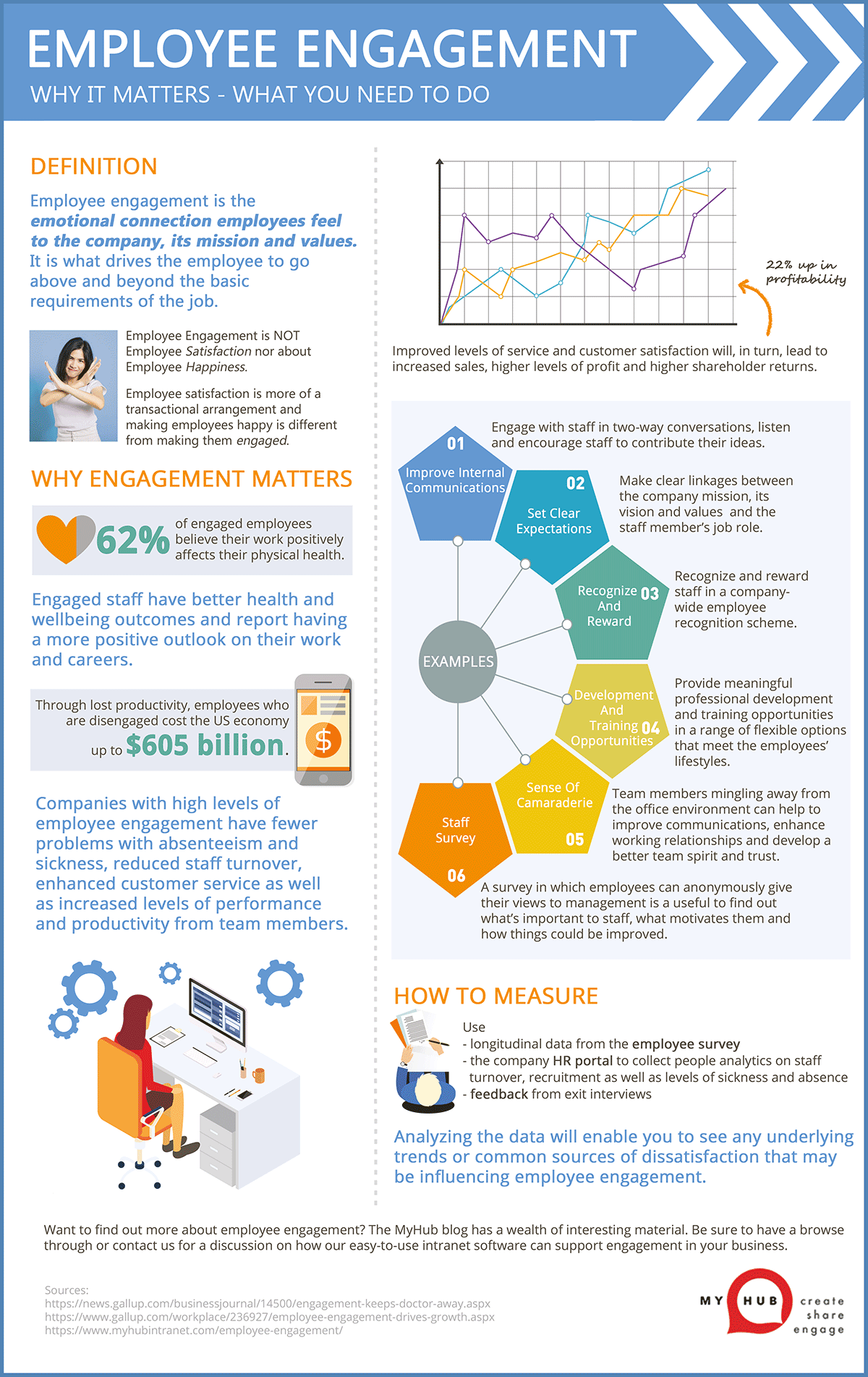
Your New Intranet Starts Here
Streamline communication, boost collaboration, and empower your team with MyHub's intuitive intranet solution.
Book a live demo now and experience the difference.
Take a Quick TourWhat Does Employee Engagement Really Mean?
What does employee engagement mean to you? Is it just another corporate buzzword or passing trend? Perhaps you see it as a “nice-to-have” initiative, something to consider only when time and resources allow. Or do you recognize it as a critical pillar of your business strategy, leadership, and company culture?
The problem is often a lack of clarity. A quick search for an employee engagement definition brings up a confusing array of interpretations, just on page one alone! No wonder many companies sideline the topic altogether. But here’s the truth: employee engagement has a measurable impact on your organization’s productivity and bottom line.
If engagement hasn’t been a top priority in your workplace, it’s time to reconsider. This article delivers a comprehensive overview of what employee engagement truly is, why it matters now more than ever, and actionable steps you can take to improve it within your organization.
Understanding The Many Definitions Of Employee Engagement
The term employee engagement was first introduced by organizational psychologist William Kahn in 1990. He defined it as:
‘The harnessing of organisation members’ selves to their work roles; in engagement, people employ and express themselves physically, cognitively, and emotionally during role performances.’ – William Kahn
Since then, many experts have built upon Kahn’s work with broader definitions:
‘Employee engagement is the art and science of engaging people in authentic and recognized connections to strategy, roles, performance, organization, community, relationship, customers, development, energy, and happiness to leverage, sustain, and transform work into results.’ – David Zinger, engagement speaker, coach, and consultant
‘Employee engagement is the emotional commitment the employee has to the organization and its goals.’ – Kevin Kruse, author
‘Employee engagement is characterized as a feeling of commitment, passion, and energy that translates into high levels of persistence with even the most difficult tasks, exceeding expectations and taking the initiative.’ – Linda Holbeche & Geoffrey Matthews, authors and business consultants
The Best Working Definition Of Employee Engagement
Employee engagement is the emotional connection employees feel toward the company, its mission, and its values. It’s the internal drive that compels employees to consistently go above and beyond the basic job requirements.
This simplified definition combines the most valuable elements from experts in the field. While it’s a helpful starting point, employee engagement is a multifaceted concept. Misunderstanding or oversimplifying it could lead to missed opportunities and ineffective strategies. Let’s clarify by examining what employee engagement is not.
Common Misconceptions About Employee Engagement
Employee Engagement ≠ Employee Satisfaction
Don’t confuse employee satisfaction with true engagement. Just because someone shows up on time, does the job well, and doesn’t complain doesn’t mean they’re engaged. A satisfied employee might perform competently but lacks the emotional investment to drive innovation or remain loyal during recruitment offers.
Employee satisfaction reflects a transactional relationship. You, as the employer, provide fair pay, a safe environment, and the tools to succeed. The employee fulfills their duties. But beyond that? There’s no deeper connection or discretionary effort. True engagement goes far beyond this baseline.
Employee Engagement ≠ Employee Happiness
While perks like free lunches, wellness programs, and team events may boost morale, employee happiness is not the same as engagement. A happy employee isn’t necessarily a productive or proactive one.
Engaged employees feel a deep sense of purpose and ownership of their work. They are more likely to take initiative, support coworkers, and drive positive outcomes. While creating a positive work culture is important, don’t mistake temporary happiness for long-term engagement.
The Impact of Disengaged Employees
Before exploring the benefits of engagement, it’s vital to understand the cost of disengaged employees. Also known as “quiet quitters” or “quitting in seat,” these workers are physically present but mentally checked out.
Definition of Disengaged Employees
Just as we’ve clarified what we mean by employee engagement, let’s set the record straight on disengaged employees. Here’s our definition:
“Disengaged employees are those who have mentally checked out of the workplace. Lacking passion, motivation, energy, and creativity, they simply go through the motions in their roles.”
Why Engagement Matters to Your Business
So, what’s all the fuss about? What difference will employee engagement make to your organization? The simple answer: engagement drives results at both the individual and organizational level. Engaged staff perform better, innovate more, and contribute directly to your bottom line.
Why Employee Engagement Is Important to Staff
When it comes to individual health and wellbeing, engagement makes a measurable difference. Employees who feel valued and connected take fewer sick days, build stronger relationships with colleagues, and report higher job satisfaction. Gallup research shows 62% of engaged employees believe their work improves their physical health, and 78% say it benefits their mental health.
Why Staff Engagement Matters to the Business
Organizations with high levels of staff engagement see fewer absences, lower turnover, and better customer service, as well as improved performance and productivity. In short, engagement translates directly into revenue growth and ROI. According to Gallup, disengaged employees cost the US economy up to $605 billion annually in lost productivity, while only one-third of workers report being actively engaged. Investing in engagement is investing in your company’s financial health.
Practical Examples of Employee Engagement Initiatives
Now that we’ve defined employee engagement and explained its importance, let’s explore six practical, low-cost ways to boost employee commitment in your organization. These initiatives are easy to implement, scalable, and highly effective.
1. Improve Internal Communications
Effective staff communication is the cornerstone of engagement, but it’s not just about broadcasting messages. It’s about fostering two-way conversations, actively listening to feedback, and closing the loop. Host roadshows, focus groups, or virtual town halls. Leverage technology, blogs, CEO vlogs, and social intranet platforms, to invite comments and ensure every voice is heard.
2. Set Clear Expectations and Goals
Engaged employees understand how their work drives business success. Use a robust performance appraisal system to link individual roles to company mission and values. Establish SMART targets and provide regular, constructive feedback, far beyond the annual review, to keep everyone aligned and motivated.
3. Recognize and Reward Contributions
A simple “thank you” can work wonders. Formalize recognition through a company-wide employee recognition scheme: employee-of-the-month awards, team lunches for standout achievements, or shout-outs in the staff newsletter. Don’t forget personal milestones, celebrating a coworker’s marathon finish or graduation reinforces that you value them as individuals.
4. Provide Development and Training Opportunities
Demonstrate your commitment to employees by offering meaningful professional development. Combine low-cost, flexible options, mentoring, shadowing, online courses, wikis, webinars, how-to videos, and podcasts, to cater to diverse learning styles. This not only boosts skills but also strengthens succession planning and employee loyalty.
5. Promote a Sense of Camaraderie
Team-building still matters. Organize offsite workshops, volunteering days, or charity initiatives to boost camaraderie and reinforce your company culture. Activities like park clean-ups, soup-kitchen shifts, or tech tutoring for seniors cultivate purpose and deepen team bonds.
6. Introduce Regular Staff Surveys
Anonymity can unlock honest feedback. Deploy quick staff surveys and pulse polls to gauge motivation, identify pain points, and gather suggestions. Tracking these metrics over time helps you measure engagement improvements and benchmark against industry peers, without causing survey fatigue.
How To Measure Employee Engagement Effectively
Focusing on employee engagement without tracking progress is like flying blind. To ensure your efforts are making a measurable impact, it’s crucial to use a variety of engagement metrics. These tools provide a clear, data-driven snapshot of how your business is performing in terms of staff motivation, commitment, and satisfaction. In addition to the longitudinal data from the employee surveys mentioned earlier, consider these insightful measurement methods:
- Leverage your company’s HR portal to collect people analytics on key indicators such as staff turnover, hiring rates, and employee sickness and absence levels. Improved engagement often correlates with better performance across all of these areas.
- Measure your Employee Net Promoter Score (eNPS). Ask: “How likely are your employees to recommend your organization as a great place to work?” This simple question reveals valuable insights, especially when compared with other performance metrics.
- Conduct and evaluate exit interviews systematically. The feedback you gather from departing employees can uncover recurring pain points and organizational issues that impact engagement at a deeper level.
Developing a Winning Employee Engagement Strategy
The biggest takeaway? Employee engagement drives business success. By implementing the strategies shared here, you’ll begin to see tangible returns , in morale, productivity, and profitability. Don’t leave employee engagement to chance. Instead, design a structured engagement strategy that includes specific goals, actionable plans, and measurable outcomes. Regularly review your strategy and make improvements where needed. And most importantly, keep your team informed of your progress and successes.
“There are only three measurements that tell you nearly everything you need to know about your organization’s overall performance: employee engagement, customer satisfaction, and cash flow. It goes without saying that no company, small or large, can win over the long run without energized employees who believe in the mission and understand how to achieve it.” – Jack Welch
Key Employee Engagement Statistics You Should Know
The Importance of Employee Engagement
- Engaged employees contribute to improved service, higher sales, better product quality, safer workplaces, lower turnover, increased profits, and enhanced shareholder returns.
- Effective communication is the cornerstone of high employee engagement levels.
- Engagement stems from emotional investment , the decision to engage comes from the heart, not just the mind.
The Current State of Employee Engagement
- Global engagement levels are at their lowest since the year 2000.
- Only 13% of employees worldwide report feeling engaged in their work.
- Overall employee engagement is at an eight-year low.
Trust in Leadership and Management
- Employees are 55% more engaged when leaders actively model desired behaviors.
- When employees feel supported by their supervisors, engagement rises by 67%.
Impact of Engagement on Profitability
- Highly engaged companies enjoy 22% higher profitability compared to those with low engagement.
- Organizations lose 20–25% of annual revenue due to disengaged employees.
- Firms with 60–70% employee engagement achieve a 24.2% total shareholder return (TSR).
- Even a 5% increase in engagement can result in a 0.7% rise in operating margin.
- TSR drops to 9.1% when engagement rates fall to 49–60%.
- Companies with less than 25% of engaged employees often report negative TSR.
- Overall, high engagement doubles a company’s chance of success compared to those with low engagement.
Connection Between Engagement and Customer Satisfaction
- Organizations with high employee engagement score 10% higher in customer satisfaction.
Engagement Drives Productivity
- Highly engaged employees are 43% more productive than their disengaged peers.
- Recognizing employees , even through simple means like an Employee of the Month program , boosts morale and output.
- Businesses with high engagement levels report 21% greater productivity.
- The most significant driver of engagement is a feeling of being valued and involved.
Employee Engagement Reduces Turnover
- Engaged employees are 87% less likely to leave an organization.
- High-engagement companies see 25–63% lower staff turnover depending on industry norms.
- Turnover drops by 65% in low-turnover companies and by 25% in high-turnover firms when engagement is prioritized.
Workplace Safety Benefits from Engagement
- Engaged employees contribute to 48% fewer workplace safety incidents.
Reduced Quality Defects
- Companies with engaged workers report 41% fewer product quality defects.
If you’re serious about transforming your workplace, explore our employee engagement action plan. Or book a free consultation with MyHub to discover how a company intranet can help you boost employee engagement and performance across the board.
FAQ Section
What is the difference between employee engagement and employee satisfaction?
Employee satisfaction refers to how content employees are with their jobs, while engagement measures their emotional commitment and willingness to contribute beyond basic responsibilities.
Why is employee engagement important for organizations?
Engaged employees are more productive, innovative, and loyal, leading to improved performance, reduced turnover, and a stronger organizational culture.
How can companies improve employee engagement?
Companies can enhance engagement by recognizing employee achievements, providing growth opportunities, ensuring transparent communication, and aligning individual roles with the organization’s mission.



